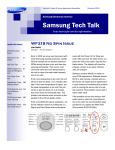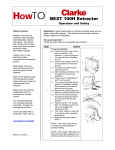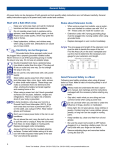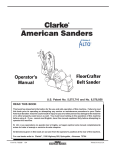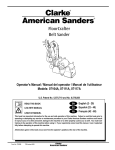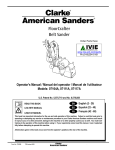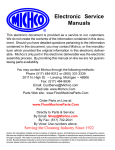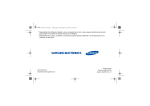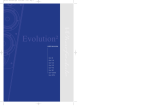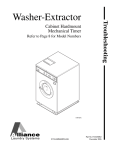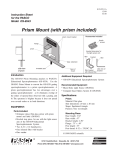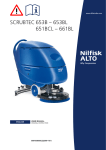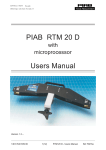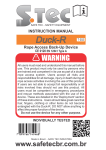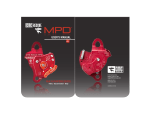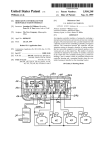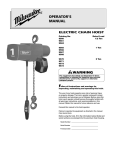Download Clarke FloorCrafter Service Manual
Transcript
MODELS: 07129A, 07111A, 07117A, 07104A 56043144 Page 1 Switch Replacement 1-Remove back cover (24) 2-Disconnect inlet and interconnect cord wires from switch 3-Remove switch retaining screws (13) on front of handle 4-Install new switch so that the levers are up in the on position 5-Connect two black wires from the inlet to the lower two switch terminals (Fig. 1) 6-Connect the black and white wires from the interconnect cord to the upper switch terminals (Fig. 1) 7-Replace back cover Assembly Hints The switch should always be installed so that the levers are up when in the on position Inlet Replacement 1-Remove 3 inlet retaining screws (9) on front side of handle 2-Disconnect all three wires from the back of the inlet 3-Connect the wires from the switch and the ground wire to the inlet with switch wires at X and Y and the ground wire to the ground terminal 4-Reinstall the inlet in the housing Assembly Hints Reinstall the inlet with the ground prong in the up position Fig. 1 56043144 Page 2 Drum Pulley Removal 1-Remove the pulley retaining nut (3) 2-Use gear puller to remove pulley Assembly Hints Install pulley with the long side of the hub in toward the drum Drum Removal 1-Remove drum cover (4) to reveal the drum retaining nut (3). 2-Hold pulley with the two flats on the hub and remove the drum retaining nut 3-Pull drum using a specialty drum puller (Fig. 2) or gear puller (Fig. 3)utilizing the vent holes in the end of the drum (Do not push the drum off by prying from the back. This will damage the rubber and cause it to separate from the core.) Assembly Hints It is easier to push the drum on the shaft and then install the key rather than installing the key in the shaft and pushing the drum over it Always turn the drum retaining washer (2) over when reinstalling it Be sure felt seals are installed in the inside of the drum to prevent dust build up which will cause vibration leading to chatter (Fig.4) When installing a new drum the drum must be trued or dressed to match it to the machine. Drum truing or dressing 1-Glue or tape a piece of 80 or 100 grit paper to a very flat surface. Use a thick piece of metal or a granite surface plate if possible. 2-Position the machine so that all wheels are on the flat surface and the drum is over the paper. 3-Slowly lower the drum to the paper while holding the feathering handle to allow only a small amount of pressure between the drum and paper 4-Hold the machine steady in this position for 10 to 30 seconds and then use a compressor to blow out the loose rubber before cooling Repeat the process if necessary to prevent chatter or vibration when sanding. 56043144 Page 3 Arbor and Bearings assembly 1-Remove arbor retaining bolts (36) located behind the drum pulley 2-Pull assembly out of the frame from the left side 3-Press shaft out from the pulley end 4-Remove bearings from shaft and carrier Reassembly 1-Press the outer bearing (35) in the carrier using the outer race only 2-Press the inner bearing (31) on the arbor shaft (32) using the inner race only 3-Press the shaft and inner bearing assembly into the carrier assembly by pressing on both races of the inner bearing while supporting both races of the outer bearing Assembly Hints Use Loctite on the outer races of both bearings. Fig. 2 Specialty drum pullers are available for removing the drum. 56043144 Fig. 3 A two or three jaw gear puller can be used to remove the drum. Fig. 4 Felt seals (part # 30675A) are used to prevent dust build up in the drum. Machines produced prior to July 2005 do not have the seals but they can easily be added. Page 4 Fan Assembly Removal and Repair 1-Remove belt guard 2-Remove three fan assembly retaining bolts (28) 3-Remove complete fan assembly 4-Remove the pulley retaining nut (24) 5-Pulley should pry off 6-Remove fan retaining nut (6) (Left hand threaded) 7-Fan should pry off 8-Remove both keys and spacer 9-Press fan shaft (35) out from pulley side 10-Remove bearings from shaft and housing Reassembly 1-Press the 902567 (smaller) bearing on the fan end of shaft using the inner race only 2-Press the 51111A (larger) bearing into the pulley side of the housing and install the retaining ring 3-Press the shaft and bearing assembly into the housing and bearing assembly using the inner and outer race of the fan bearing while supporting the inner race of the pulley side bearing 4-Reinstall fan and pulley Assembly Hints Fan spacer is installed with the wide flange toward the fan The pulley is installed with the long hub side toward the bearing The fan and pulley keys are interchangeable Fan retaining nut is left hand threaded If the fan doesn't spin freely after assembly - gently tap each end of the shaft to free the bearings 56043144 Page 5 Truck Assembly Removal 1-Remove drum pressure lever (13) and spring (14) 2-With the machine lying on the access door side loosen the two set screws (52) in the bottom of the truck frame 3-Disconnect the drum control rod assembly (3) from the truck frame (55) 4-Screw a 1/4-20 bolt into the left end of the shaft (58) and pull shaft out (Fig. 5) Assembly Hints Both the rubber (63) and metal (45) spacer go between the truck frame and leveling bracket If the eye bolt (40) is removed from the truck frame be sure to measure the threads for reassembly The tension spring (14) is installed with the short end connected to the drum pressure lever Truck Wheels Truck wheels (51) can be removed & replaced without removing the truck frame Rear Caster assembly Rear caster and pivot axle assembly can be removed by removing the nut below the handle base (17) or the lower assembly only can be removed by removing the lower nut (27) leaving the pivot axle in the mainframe. 56043144 Page 6 Fig. 5 Using a 1/4-20 bolt threaded into the shaft will prevent damage to the shaft surface when removing the shaft 56043144 Page 7 Tensioner Assembly Removal and Disassembly 1-Remove paper tensioning handle (34) 2-Remove three tensioner mounting bolts from left side of frame 3-Pull complete tensioner from paper access door side 4-Remove top roller assembly 5-With the tensioner in the compressed position use a C-clamp or bar clamp to compress the tensioner spring (Fig. 6) 6-Remove upper link arm bolts (11) 7-Release clamp to separate the support (29) and carriage (18) 8-Remove Bolt from upper and lower rod ends (24) and (33) 9-Remove the draw lever pivot bolt (30) 10-Bring the draw lever out through the top of the support Upper roller bearings 1-Remove snap (8) ring from short side of shaft (15) and drive shaft through from this end 2-remove bearings (9) from shaft and roller 3-Press new bearing on long end of shaft using inner race only 4-Install inside bearing in roller (Should be a slip fit) 5-Press shaft and bearing assembly into the roller and bearing assembly using only the inner race of each bearing. (use Loctite on the outer races of both bearings) Guide roller Bearings Guide rollers are not serviceable and should be replaced as complete assemblies Assembly Hints If replacing the support (29) add or remove spacers (37) as needed If replacing the rod ends (25) mark the center of the all thread (31) to make sure there is equal engagement in both rod ends (Fig 7) The gap between the rod ends should be approx. 3/8 (Fig 7)so that the single end on the draw (6) lever just contacts the lower side of the support (29) when compressed (Fig 8) and the carriage protrudes through the support approx. 1/16 (Fig 9) Check to make sure the outer arms of the draw lever 9 are parallel (Fig 10) Draw levers prior to 2007 were soft steel and prone to bending Fit between carriage and support must be free but not overly loose Do not use lubricant other than aerosol Teflon on any of the moving parts Machines produced before 2009 do not have the stainless shims in the support or carriage and shims can not be added without replacing the support and carriage Make sure the metal wave washers (14) are installed between the link arms and carriage (Fig 11) Upper link arm bolts (11) will break easily if over tightened One to three threads of the tracking adjustment screw (17) exposed through the underside of the carriage (18) is a rough starting adjustment (Fig. 12) Rubber boot (39) most be glued to the carriage and wire tied to the support to seal out dust 56043144 Page 8 Fig. 6 A clamp should be used to hold the tensioner in the compressed position during disassembly Fig. 9 If shaft is not at least flush with the bottom of the casting when compressed it will be difficult to install sanding paper Fig. 12 56043144 Fig. 7 Center of rod has been marked to show equal thread engagement in the two rod ends and gap is set at 3/8 as a starting point. Fig. 10 Fig. 8 Fig. 11 Washer must be in place to prevent the shoulder bolt from compressing into to aluminum carriage Fig. 13 Page 9 Testing the Capacitors 1-Disconnect all wires from the capacitor to be tested 2-With an insulated screwdriver short the terminals on the capacitor together to discharge it 3-With a multimeter set to the ohm setting attach one probe to each terminal (Fig. 14). If the capacitor is good the needle should move up momentarily and then fall back to zero. You can repeat the test by reversing the leads on the terminals. If the needle does not move or moves up and does not fall back the capacitor is defective. Testing the electronic start switch (SINPAC) With a multimeter set to the ohm setting check the resistance between terminal 2 and 3. If the resistance is less than 500K the switch has been shorted and must be replaced. It's possible for a defective start switch to pass this test and still not function but further testing requires specialty tooling. If the start switch passes this test and the motor shakes and will not come up to speed the start switch is most likely defective. Fig. 14 56043144 Page 10 Symptom Cause Repair No power Defective switch Defective start switch (SINPAC Switch) Defective start or run capacitor. Poor connections Defective motor Check power supply and connections Replace switch Replace start switch Replace defective capacitor Check connections Replace motor Low voltage from excessive length, undersize extension cord, or poor connection Defective run capacitor Defective motor Locate power source nearer to work site or use a Voltage Booster. Check connections. Replace capacitor Replace motor Defective start switch (SINPAC Switch) Replace start switch Leveling out of adjustment Readjust Level Chatter Paper tracking out of adjustment Sanding in wrong direction Damaged wheel or rear castor pivot rod Drum damaged or out of round Adjust tracking Sand from left to right Replace damaged wheel or pivot rod Dress or replace drum Clean drum Waves Excessive buildup of dust in the drum Vibration from damaged or worn bearing or belt Defective sanding paper Sub floor loose or not installed properly Debris on wheels Flat spot on wheels Sub floor loose or not installed properly Replace wheels Repair sub floor Improve smoothness of starting and stopping or reduce sanding pressure Motor will not start. Motor runs sluggishly Motor shakes and will not come up to speed Uneven cut / lines in floor. (Lines running with the direction of sanding) (Less than 2 inches between marks.) (2 inches or more between marks) Excessive stop and start marks 56043144 Replace worn or damaged bearing or belt Replace paper Repair sub floor Clean or replace wheels Page 11 Symptom Paper not tracking Cause Repair Tensioner not adjusted properly Paper not tensioned Adjust tensioner (If machine has been ran with the paper untensioned there will be noticeable paper cut marks on the upper rod end) (Fig 13) Poor dust pick-up 56043144 Excessive buildup of dust around tensioner Worn upper roller or guide roller Draw lever damaged/bent Excessive play between the upper carriage and support Drum damaged or out of round Leveling out of adjustment Defective sanding paper Dust bag is over 1/3 full Tension paper Clean tensioner Replace worn roller Replace draw lever Replace tensioner assembly Dress or replace drum Readjust level Replace paper Empty bag Shake debris from bag and wash or replace Dust bag is dirty bag Dust shoe is improperly adjusted Readjust dust shoe Dust chute is obstructed Remove dust shoe and clear throat Fan belt loose, worn or damaged Tighten or replace fan belt Page 12 14600 21st Avenue North Plymouth, MN 55447-3408 www.clarkeus.com Phone: 800-253-0367 Fax: 800-825-2753 ©2010 Nilfisk-Advance, Inc. A Nilfisk-Advance Brand














